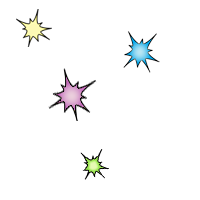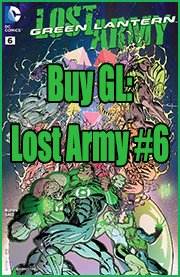Green Lantern Volume 3 #14 – 17 + Green Lantern: Mosaic #1 – 18 cont…
on September 25, 2013
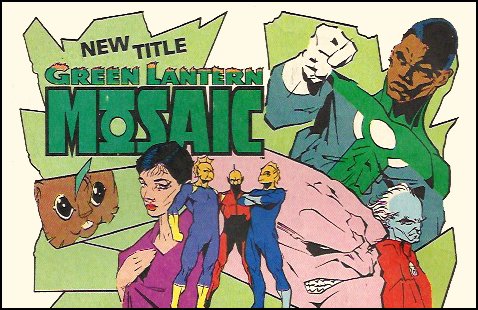
Cully Hamner sits Mosaic #9 out and Mark Beachum steps in. Behind Hamner and Bright, Beachum is the best artist to render The Mosaic World and its characters, but this is the only issue we see his work. “Merry Mosaic” is a Christmas story about a holiday party that John and Rose throw in John’s Mosaic pad.
The issue addresses a number of engaging topics, such as stereotypical expectations. Rose thought that John might want to celebrate Kwanza, saying that she read that fifteen million African Americans observe the holiday, but John says it must be the fifteen million he doesn’t know. One of Rose’s friends, Ibrahim is from Palestine, and John assumes him to be Muslim, but Ibrahim tells John that he’s Christian, and that about half of Palestinians are.
Salaak attends the party, but doesn’t have much to say. Ch’p’s death is also touched upon. Xudarians, a Berserker, and Steamfrogs come over, as well as The Mosaic Kids.
The group reflects on their different holy ceremonies while John contemplates what Christmas means to him. Naturally, he doesn’t view it like your everyday person would. He has thoughts of death and childhood memories. While considering the memories of their ceremonies and customs, the characters become sad, as they draw their thoughts to home, and how they may never see it again.
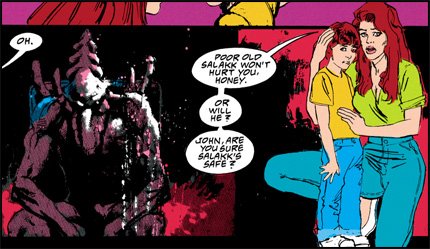 |
|
Salaak has been behaving odd lately. Odder than usual for Salaak. |
Suddenly, the Pans arrive, who are an alien race of eternal children. Their antics begin to cheer up the whole gang, and John tells the one story of Christmas, which includes elements of all the cultures of the attendees.
John realizes that to go forward, you need to go back. The Pans -children- brought people out of their stupor, and Rose and the gang began thinking productive thoughts again, like making plans for a Mosaic fair.
John says some things that don’t make much sense, but that will. He says that he expels The Red within himself, because he always thought a good man should be the color of a steady growing tree.
He contemplates how he’s getting closer to the secrets that will fuse the whole Mosaic together, and returning to his memory -going back- gets him closer.
Issue #10 makes me wonder what people are talking about when they say John Stewart is a different character all the time. The sense of humor he displayed under Wein and Englehart is front and center here, and his interaction with the Guardians is similar to what we saw then.
In the story, “Ways to Go,” Green Lantern confronts the Guardians about sending the cities home. He feels the experiment should be concluded and that the cities should be returned to share what they’ve learned from their time on The Mosaic. The Guardians are aware that what they are doing may seem cruel at John’s level, but it’s all relative. They decide to take a look at The Mosaic World so John Stewart conjures a flying bus with his ring that he uses to ferry the Guardians around in.
This issue is really fun because it’s another example of the excellent world building that Gerard Jones does. We’re shown many different races and Jones clearly has fun depicting how wild and wacky they are, but also giving them some sense of reason.
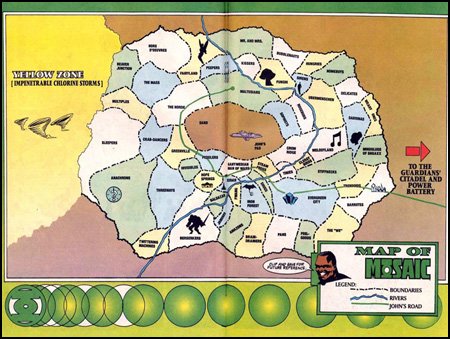 |
|
A map of The Mosaic. Clip and save for future reference! |
There are the Bubblenauts, sentient blimp-like creatures who ride up and down on atmospheric thermals. They lose a lot of water through evaporation and often raid the water supplies of other Mosaic cities to replenish. In turn, the cities would harpoon them out of the sky. John Stewart solved this issue through a water rights agreement. Not only do these insights introduce us to some of the races the comics haven’t had time to go into, but they go into a lot of the stuff John has been doing off panel.
We’re shown a city of holy importance where the high priests reach out to other beings on The Mosaic. John encourages religious freedom. Aliens moving to new alien faiths really shows how much of a real society is taking shape.
John takes the Guardians to see one of my favorite races in the whole Mosaic, the Twittering Machines! John defines them as “mechanical contrivances of an unknown race.” They’re machines that look like a television antenna mixed with a bird’s head, and they speak in many different dialects. When John sees them, one says, “Oh lordy. John Stewart has come a-callin‘,” and “John you has frazzled they gizzards. You always doin’ that.” They don’t seem to make much sense, but that’s what makes them so fun. John uses them for loosening up tense negotiations.
One of the weirder races is the Hungries. They eat everything in sight, and when they don’t they can get violent. The Mosaic handles its sanitation problem by piping all their waste to the Hungries to be eaten up. It’s a clever example of how Green Lantern has found a way to make the different alien races have a place that helps the overall structure of the developing society, which is what Rose suggested he do way back in Green Lantern #14 – 17.
John Stewart proudly displays his great triumph to his Masters: The Road. It is used to bring food in from the farm belt and the different races use it for trade.
Something goes wrong when two races start fighting. The Mosaic Kids are on the scene and they break the situation up. John has to admit that not everything is perfect, but points out that they have made strong advances.
It is interesting to see the Guardians meet some of the human characters like Rose Hardin and the Mosaic Kids. Rose tells them about the Mosaic fair she is putting together, and how she plans to use it to help the different people get to know each other, through food, games, and music, and John tells the Guardians about how sharing power is the way to make the Mosaic work, hence why he bestowed weaker rings to the children.
One aspect I really like about this issue is the double spread map of The Mosaic that is included. It really shows how much there is to explore, and how much potential the series has for captivating stories. There are many wondrous areas and races to be seen, some that John doesn’t understand and hasn’t been able to make contact with, like the creatures in the massive Yellow Zone, which is a large area caught in a constant yellow chlorine storm, which makes it off limits to John. Occasionally, he can see shadowy shapes in the storm, which are sometimes humanoid and other times not.
This issue really makes me wish this series went on longer, because it displays so much potential for many great stories, as there are many places and peoples that we sadly never see explored.
The Guardians like how the Mosaic is progressing, but feel that the experiment must continue. John gets the impression that the Mosaic doesn’t occupy too much of their thoughts, and he felt like a child showing a parent his science project.
In “I myself am Mosaic,” the story takes a bit of a different turn. Instead of having adventures on the Mosaic that showcase the weird and wonderful happenings, we start going into the secrets of Mosaic to discover What is really going on.
The whole issue is a dream sequence that sees John Stewart waking up in the old house he lived in as a kid, but he’s a grown man in his Green Lantern uniform. His interactions with his dad are really great. His father lectures the mighty Green Lantern, and John, not totally adapted to his new old environment, tells his dad that he thought he heard the last of his speeches long ago. Unsurprisingly, his dad’s anger flares up at hearing that and he yells at John, telling him he’s going to keep on hearing them until he learns. We get the impression that his parents see John as his child self, though he looks like a grown man to the reader.
John visits his mom, who is dying from cancer. John tells her how he always asked her why she had to be sick and his mom answers by telling him God has a plan for each of us. He puts his hand on our heads and asks us to walk with him. John never understood why his plan meant such pain. There is a really funny moment here. While John is having this touching heart-to-heart with his mom, his dad, from out of nowhere whacks him in the back of the head and tells him to hurry up and get to school so he can learn and make the white man need him in order to get to a better place.
This issue showcases adults saying things to children that are vague, and as a kid these things can make you wonder. They don’t totally explain a situation for you. John Stewart does wonder.
He walks through his neighborhood and reflects on the better place his dad told him about. John always thought it meant a better neighborhood. He would pass through the wealthier neighborhoods and contemplate the buildings there. It’s always nice to see John’s history as an architect brought out. He describes the different sorts of buildings in the different neighborhoods in detail.
He goes to visit his grandmother, who is a step below his parents in terms of living quality. John finds his grandmother morning his dead grandfather, but wonders why she’s doing it, since he was so horrible to her. His grandfather appears with a knife jutting out of his chest and blood gushing from the wound, but he doesn’t seem to notice.
John’s grandfather took up living with another woman in the projects and John begins thinking of that place. He looks at that as the lowest of the low. Hell. If he ever lost his grip, that’s where he would wind up.
While at the projects building with his grandfather, John finds Ch’p in a tree, and climbs the tree with him. His grandfather suddenly realizes there is a knife in his chest, and collapses in death. John thinks Ch’p should be mad at him, because John let him die. John tries to reason with Ch’p, telling his fellow Lantern that it was all Sinestro’s fault. That the evil Ch’p saw in John was Sinestro.
Ch’p explains that John intentionally welcomed Sinestro into his mind. John can’t understand that, but as the two reach the top of the tree, they find the Old-Timer, who, like God, puts his hand on John’s head and asks him to walk with him. John wants Ch’p to come with them, but Ch’p says he’s gone as high as he can go. He cannot go beyond the top of the tree. John has also gone as high in the green as he can, but he can go higher because he has Something Red.
Together, The Green Lantern and the Guardian walk up a stairway in the sky, which leads toward a floating ziggurat that reminds John of the buildings of Katma’s people. Appa tells John that he needs to open the door, but John can’t do it, and suddenly he awakes. A vision of Ch’p appears as emerald energy and tells John that he needs to crack the nut.
This issue is great because it really shows where John Stewart came from. We get a real sense of what his life as a child was like. It contradicts a few things with previous Green Lantern comics, but oh well. And it is pretty much the beginning of when John starts getting closer to the truth.
There’s no rest for the weary! John’s next Mosaic trial has him facing off with the KKK. It turns out Moses Rockwell is a clansman. He ponders upon his past actions against John Stewart and admits that he went crazy with rage and a smarter way of doing things will need to be employed in his crusade against The Lantern.
Rockwell and the clansmen attack the home of an elderly couple who is hosting aliens. John Stewart gets wind of this and disrupts the attack. As much as he wants to kill the offenders, he lets them go.
John notes that the challenge of The Mosaic is respecting all cultures and finding ways for them to compromise. He goes back to his dwelling, and seeks Rose’s advice. He ruminates on what Ch’p told him about going as high in the green as he could, and needing to bring up The Red. John thinks that maybe “The Red” symbolizes violence, and that perhaps Ch’p is trying to tell him to give into that side of himself to bring The Mosaic together.
Rose is somewhat incredulous about John seeing Ch’p, seeing as how the squirrel-like Lantern is dead. John brings out that the Old-Timer is dead and he still talks to John in his head, and that Sinestro was supposedly dead, but he entered John’s mind as well. Rose presents the possibility that what may have happened when John was possessed by Sinestro may not have been Sinestro at all, but could have been John breaking under the stress of managing The Mosaic World. John is surprised that Rose thinks that he would harm her or Toby.
The two try to settle down to get some sleep, and John dozes off while weirdly reading a Hal Jordan Green Lantern comic book. Another dream sequence begins, which features the Minister X-Men, who are an all-black super team. They get into a battle with a group of villains called The Blue Eyed Devils. Almost all of them are white, barring the Integrator, who is John Stewart. The Blue Eyed Devils mention a character named Red Queen. As John is battling Minister X, the Red Queen arrives and she is Katma Tui, who says “Come to me my sweet embraceable you!!”
John immediately wakes up and wonders what this all means. The quote from Katma was taken from a Gershwin song, and Old-Timer also used lyrics from Gershwin songs when he first possessed John’s mind. John wonders if the dead Guardian is behind the dreams. Rose, who wakes up alongside John, brushes all the craziness aside once again and tells him he’s been listening to his CD’s too much.
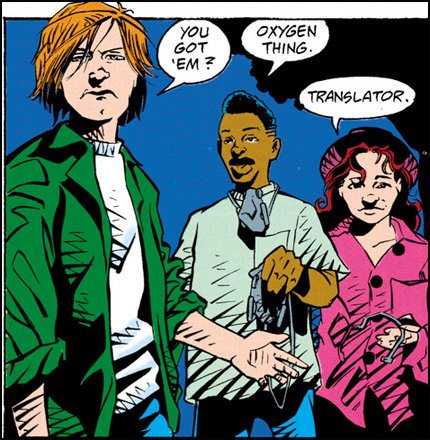 |
|
The Mosaic Kids. |
Suddenly, John gets a message from Mosaic Kid Kelly through his ring. Someone set fire to the human town of Beaver Junction and she can’t handle it all herself. John zooms off, preparing for another confrontation with Moses Rockwell’s group, but he’s amused when he finds a group of aliens dressed in Klan robes.
Issue #13’s story, “What Xenophobia Means to Me” is another one of those issues viewed through the perspective of another character. It begins with an alien known as a Peeper as he is leading the attack on Beaver Junction. It is the Peeper’s ultimate goal to simply escape The Mosaic, and he is doing what he feels necessary to realize that goal.
He sat back and observed the humans, and took special note of Moses Rockwell. He realized that the two of them are largely alike.
It’s enthralling how Gerard Jones writes the Peeper. He convincingly comes across as alien, and as a usual observer who doesn’t say much, but has a ton of thoughts racing through his head. Despite that being the case, the Peeper is a being of action here.
His objective is to get Green Lantern. He contemplates how bizarre and contradictory Green Lantern is. To get him, he knows he must do it through Rose.
Moses fleas Beaver Junction with two of his buddies. Rockwell also realizes that Green Lantern is the key to getting back home. Rockwell comes to the same conclusion as the Peeper, and decides Rose is the best way to get to Green Lantern. Just as he comes to that realization, he’s attacked by an odd alien being and begins thinking about his past.
And thus, we get an origin of sorts for Moses Rockwell. It’s a look into how a person like Moses Rockwell can come to hold their views and values.
Moses Rockwell looked up to his father, who was a farmer. He credits him as being the sort of person who built America. But as time went on, and America turned to industry and its labor pools of immigrants and blacks, people like the Rockwells were neglected. His family moved to the city, where they tried to survive. His father died in World War II, which Rockwell resents, believing that America should have tended to itself instead of fighting for the Jews and the British. His mother remarried a man who beat Moses and was prone to drunken anger. When Moses became a teenager, he joined a gang of racist teens and learned that there is strength and security that comes with being in a group.
Past that point, he grew up, became an insurance salesman, and got married. Moses tried to get the racist feelings out of his system, but as he saw the government helping blacks with welfare and affirmative action, while doing nothing for the whites whose lives were getting harder, he just couldn’t shake those feelings, especially as blacks moved into his neighborhood and lowered the standard of living. He moved, but the same thing happened again. Finally, he arrived in Greenville. But look where that got him; on The Mosaic World surrounded by aliens.
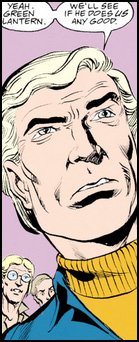 |
|
Moses Rockwell. A family man whose son was killed by The Horde. He hates Green Lantern and aliens, and is determined to do what it takes to leave The Mosaic. |
Sadly, Moses was mugged in his own drive way by two young black men and left bleeding. That depressed him so much he turned to drinking and considered suicide. Moses found new resolve and a new reason to live when a friend brought him into a white men’s fraternity. A group where white Christian men stuck up for one another.
It’s revealed that this introspective look is brought on by an alien called a Brain Drainer who finds human memories especially appetizing. The Peeper saves Moses from the creature.
Props to Gerard Jones for finding a unique way of getting into Rockwell’s past!
The Peeper decides not to save Moses’ friends. He tells Rockwell about how communication with anyone off of Oa is blocked. The Peeper’s plan is to use Green Lantern to send a message to get the people of Mosaic off the planet. The Peeper has a completely understandable motive. While he’s an antagonist, he’s quite sympathetic, as is Rockwell… to a degree. No one asked to be put on The Mosaic.
The Peeper also enlists the help of an Amazon. The Amazons’ mating time is getting closer, and with no males of their species on planet, they could give into the urge to mate with other species, which repulses them.
The trio arrives at Rose’s house, Rockwell pulls a gun on her and they wait for John Stewart to arrive while holding Rose and Toby hostage.
Green Lantern is back at Beaver Junction with Kelly. The situation there has settled down, but John fears the humans will counter attack the aliens in the morning. He knows he needs to break the circle of violence but isn’t sure how. When John arrives at Rose’s house, he’s ambushed by the Amazon, who knocks him unconscious. The Peeper can control his ring through his unconscious mind, and plans to use that as a means to call for rescue.
This particular tale is notable for exploring the motives and history of Moses Rockwell, who is definitely a fascinating character. As previously mentioned, I’m especially impressed that a character as powerful as Green Lantern has an ordinary insurance salesman as a primary foe. Not a genius sociopath with a fortune. Not a genius psychotic homicidal clown who refuses to die. Rather, your everyday insurance salesman. That’s the kind of stuff that makes Mosaic so different and great.
The following issue is another venture into the surreal… but, I guess that could be said of the entire series. With this issue, artist Luke McDonnell hops on the Mosaic series. His work isn’t as striking or seamlessly appropriate as Cully Hamner’s, but it isn’t terribly disappointing. He draws a good Rose Hardin, and keeps within the spirit of the series, though he does make some changes. The Glad Girls are given a more mature look than the childish depiction Hamner created them with, and speaking of that, his women are more… pronounced. For instance, Rose Hardin’s breasts are notably larger. His art is more generic, and what made Hamner’s style work so great is that Mosaic was never meant to be a generic superhero story. Hamner’s whacked out look and slanted layouts fit like a glove. And before that, M.D. Bright’s pencils were so consistent and well done that it is difficult to find fault. McDonnel isn’t as daring or fitting as Hamner, and simply not as great at the craft as Bright, but he does an okay job.
John Stewart is playing a board game with Rose and Toby in the house and suddenly notices plants with massive purple pods on them outside the window. They have grown all over the place. Rose doesn’t feel threatened by them, and neither does John, but the Green Lantern decides it’s best to investigate. He visits the Xudarians, who have been studying the pods. They have not found anything portentous about them, either. John gets angry when he sees a race he calls the Ubermenchen burning the pods. He sees Rose and Toby’s faces in the flames, telling him to fight back.
 |
|
Green Lantern with his new family, of sorts, Rose and Toby Hardin. |
He zooms back to Rose’s house to find her and Toby playing the board game, replaying the scene that the issue opened with. When John starts to smash the pods, he gets a glimpse of what he thinks is reality – a vision of him being taken advantage of by Moses Rockwell and the Peeper.
John eventually bites into one of the pods, and within it, he sees a smaller version of himself sitting at a piano, surrounded by even more pods, but these ones have faces. The small John rings up a standup bass and guitar, and plays classic Jazz music, but suddenly Salaak appears to him as a winged horse. Salaak says it’s their time, and that he will take John to reality. John hops on him and they see a vision of John lying on the floor with his assailants.
Salaak explains that John’s mind fought for reality, but the Peeper induced a state of wishful thinking upon his psyche, and the image that appeared to John was of Mosaic harmony. John wants Salaak to help him wake up so he can stop what is happening, but Salaak tells him that the vision they are watching of John laying unconscious is not the true reality. It is a game John plays to keep peace of mind. John wants the truth, so Salaak kisses him and blows out many small versions of Ch’p. John follows Ch’p and walks down a long staircase where hands grab him and pull him under. Ch’p tells him that to discover the truth, he must confront his own personal hell.
Sounds really strange, right? Up to this point, this may be the oddest piece of the Mosaic… and it, like issue #11’s story, “I Am Myself Mosaic,” are even a bit on the eerie side.
There are some great moments in the issue, like John getting bothered by the simplest things, like when a Xudarian scientist tells him that he’s unlike any other Green Lantern and fascinating. Naturally, those would seem like compliments, but they makes John feel alienated. He is truly unlike the other Green Lanterns and he doesn’t fit in the super hero medium in this story.
There’s also a fun moment when John has a sudden impassioned argument with an alien known as a Sophist about reality. It would seem to come out of nowhere, but reality and the perception of it is what this issue is all about.
Salaak and Ch’p’s true role in the Mosaic storyline is to serve as guides as John Stewart searches for the truth… about himself, about The Mosaic, about all of this! This is what Ch’p means when he says, “Crack the nut.”
This is an important issue, because it’s here that John begins to realize the truth. The pods represent a reality that John has settled for, though not necessarily a true one.
The journey of self-discovery continues…
Issue #15 is perhaps the most intense issue of the entire Mosaic storyline. It’s also the last issue drawn by Cully Hamner, unfortunately. John finds himself at his beloved road while accompanied by a group of Ch’ps. Suddenly, the yellow truck comes down the road and kills all the Ch’ps and John follows it, discovering that it’s being driven by the Old-Timer!
John hops in the passenger seat and Old-Timer drives to the destruction of Xanshi as it’s happening and forces John to face his greatest failure again, up close. Then the Old-Timer and John see the alien known as Priest alongside the road and the Old-Timer runs him over, symbolizing that Priest’s blood is on John’s hands as well.
Out of nowhere, another truck collides with the yellow truck and the Old-Timer dies. It turns out Hal Jordan was driving the other truck and he gets out and has a talk with John. Hal tells John they had to kill the Old-Timer because he was endangering the harmony of the cosmos, that the death of Priest was beyond John’s control, and that Xanshi was a miscalculation. It’s interesting that what Hal is saying makes sense, but Hal Jordan and his reasoning seem so intentionally out of place and foreign in this bizarre comic series.
John doesn’t want to hear anything Hal has to say. He doesn’t want to hear Hal lecturing him about what a hero and a man should be. Hal turns into Sinestro and further taunts John in his own way. Afterward, John is confronted by two of his most hated enemies; The Predator and Star Sapphire. They are the ones responsible for the death of Katma Tui. John gets into a fight with them, and admits that he’s wanted to kill them for years.
They further confront John Stewart with his failures. The Predator knows John told himself that he would save Xanshi, but all he did was destroy it, and that he was going to fight to stop the Old-Timer, but all he’s doing… before the Predator can finish, John emits a large emerald burst, incinerates both enemies while screaming that they are lying to him.
And when they’re gone… he sits back and admits that it’s all true.
Once John admits the truth about himself, Ch’p returns and the duo walks down the road. John admits to the dead Lantern that he built structures to help deal with the death that always surrounded him. When he met Katma, he built everything around her. When she died, he felt he had to be a savior, and that is why he tried to save Xanshi all by himself, but failed. In light of that error, he had to be a universal savior to make up for that, which is why he unconsciously took control of the Old-Timer’s mind, and…
Created The Mosaic himself!
The big revelation!
John Stewart is, in some sense, his own worst enemy.
He brought Sinestro out of the Central Power Battery and allowed himself to be possessed by the renegade so that he may have the strength to efficiently run The Mosaic World. When John had taken on enough of Sinestro’s will and attributes, he discarded the rogue Lantern.
Ch’p tells John that he is on his way to fully cracking the nut when the ground of the road bursts open and John descends through the pit. He wants to ask Ch’p more questions, but they become separated. John finds himself in a dark cave talking to himself, trying to make sense of things, such as why death always surrounds him, if the Guardians know that he created The Mosaic, why they’re really continuing the experiment, and why Star Sapphire killed Katma. He gets no answers, but is faced with a red pool that begins forming into a body. It turns out that it’s…
Katma Tui!
Wherever it is they are, John wants to stay there and be with Katma, but she says that isn’t necessary, as they will leave together and discover the rest of the truth!
This is an incredible issue and one of the best out of all of these stories. We really see how deep a character John Stewart really is. He is one of the most conflicted characters I’ve ever encountered in fiction.
Hamner’s art is at its best here. The Old-Timer looks truly sinister and scary, which goes hand in hand with Jones’ forceful script. This comic actually sent chills down me the first time I read it, and still does today.
The momentum doesn’t let up, as Gerard Jones and Luke McDonnell take a look into the mind of Rose Hardin; a character who has been in this Mosaic story since the start, but who has kept much of her thoughts bottled up. In issue #16, we get to fully see who Rose is and what makes her tick.
In many ways, Rose is the opposite of John, but in other ways, she’s just like him. She doesn’t believe in hopes and dreams, songs, or in super heroes, and her thinking is rather simple and straightforward for the most part. These traits are not like John Stewart.
However, Rose, who’s spouse died, didn’t have much going on for her on Earth, but she was able to play a large part in building a world on The Mosaic. In this, we realize that she does have a lot in common with John.
While Rockwell and his gang manipulate the unconscious John Stewart in her home, Rose is powerless to stop them, so she tries to clear her head by working in her field, and considers her life and memories. She thinks about her father and how he left their family to go live some dream. After that, she didn’t look to dreams anymore and was even afraid of them. She thinks back to the time when the town of Hope Springs was called Desolation, when Hal Jordan and Green Arrow arrived to settle a fight between the mine workers and owners who ran the town.
She contemplates how super heroes are like demigods and how the people are frightened of them, despite pretending like the heroes are normal people. Another riveting point about Mosaic is brought up here. It takes a totally different perspective to super heroes than what we usually see, and in some ways, it might be a more realistic one. It jumps out of the regular super hero comfort zone and presents the entire concept in a different light.
Through Rockwell and the Peeper’s efforts, an armada of ships arrives at Oa to take the captive cities home, and Earth’s super heroes, including Hal Jordan and Guy Gardner, appear to take part in this, too. What makes this issue special is that we see the craziness of super heroes meet and clash with the craziness of Mosaic, and we’re left wondering which is more crazy.
Gardner and Jordan bring out the insanity of the whole situation on The Mosaic, especially of how John gave power rings to children. When you think about it, that does sound like a weird thing to do, but within Mosaic, it works. Likewise, Rose considers the heroes and what John told her about them, and from her point of view, they’re the ones who seem weird and like something is wrong with them.
There are a few real antagonists of Mosaic. Moses Rockwell is one, Old-Timer is another, and, interestingly, Hal Jordan kind of fits in there, too. It seems like everything Hal stands for is against The Mosaic. It seems like he’s too boring, too straightforward, and too predictable to exist in this world. Whenever he appears, he is at odds with the main characters. And every time he shows up, he takes stronger and stronger actions against the characters.
First, he said nothing about John wanting Rose to stay on The Mosaic instead of going back to Earth, but he obviously didn’t like that. Second, when Rose turned down Hal’s direct offer to return to Earth, he wanted to probe John’s mind to see if John was making Rose stay there against her will. Now, Hal Jordan seeks to destroy The Mosaic entirely, and because of that, he is Rose’s enemy.
It was never specifically said, but Rose Hardin came to love The Mosaic. She had a large hand in shaping what it is now, and that is greater than anything she ever accomplished back on Earth. The town of Hope Springs uses the saying, “Our daddies broke rocks, we break dirt.” On The Mosaic, that saying takes on a whole new meaning for her. She’s a trailblazer, building a new world with new opportunities. She loves John Stewart because he shares her passion. He symbolizes The Mosaic for her, and she is totally behind his dream of Mosaic harmony. She sees beauty in John’s perceived madness and appreciates that he embraces that madness and also that he is willing to be a father to her son. From her perspective, Hal Jordan cannot understand or appreciate any of that.
Hal Jordan stops the Peeper from further manipulating John, but the Peeper reveals that he let go of John’s mind a while ago. His mind is off in some other reality. Hal continues to try to reason with Rose, but she won’t give an inch. Rose desperately wishes for John to wake up, saying that he will stop the heroes from destroying The Mosaic, and that she will stand by him, and he will stand by her.
John does wake up, and when he does, Katma Tui suddenly appears in the room, to Hal and Rose’s astonishment.
Hal Jordan continues to come across as rather ignorant in the following issue.
The heroes of Earth go around to different settlements of The Mosaic and learn that many of the inhabitants want to stay. Their situation is better on the Mosaic than it was on their respective worlds. Hal Jordan comes to realize this when he sees a baseball game (something that connects with him personally) taking place in Evergreen City. He notices many of the participants are aliens. He has a talk with a human baseball coach who is really excited about teaching the sport to passionate aliens. He was finished in baseball and couldn’t even get a job as a high school baseball coach back on Earth. But on The Mosaic, he found a new purpose. Hal has to admit that the sight of the aliens getting along is beautiful.
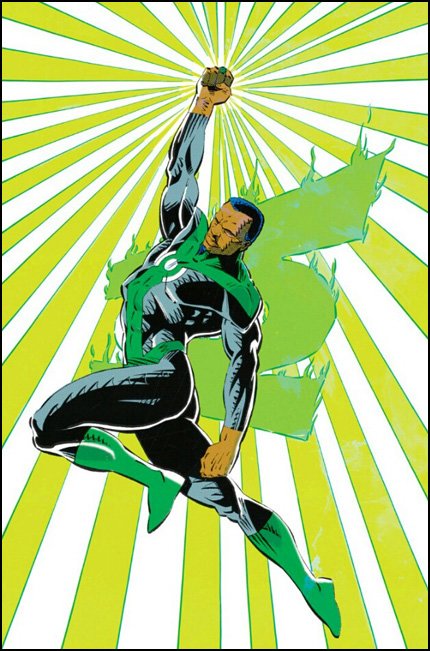 |
|
Green Lantern, caretaker of The Mosaic World. |
To be fair, the issue shows that not all inhabitants of The Mosaic want to stay there. The Barriites are very excited to leave, and the people from the Holy City of Baldazar are, too.
Hal Jordan visits a city of the Maltusian race and they report that John Stewart is actually a messianic figure from their prophecies, called “The Opener of Doors.” This individual was prophesied to create a new world that would lead people to solutions. The Guardians of the Universe also believe in this prophecy.
Hal Jordan, confused as to what to do, summons the Guardians for guidance, but as ever, they will not interfere. The heroes agree that it isn’t a good idea to force people to leave against their will.
This whole time, John Stewart is sitting on the porch of Rose’s house with his newly resurrected wife, and Hal is upset that John isn’t doing anything to straighten the situation out. Hal starts to get a little too excited and John warns him that they’ve fought before and John defeated him. Now John is in contact with far greater power; power that can even reach through the wall of death, as Katma Tui points out early in the issue.
The Steve Englehart Green Lantern Corps characters are reunited, with Salaak back in his old uniform, Ch’p seemingly alive, and Katma by John’s side. It’s cool to see them together again. The Steve Englehart period was when things were really cooking for our Green Lantern characters, and since then, we get the impression that things have just fallen apart. Seeing the characters back together instills a real sense of life and excitement in this book.
The Amazons don’t like the sounds of the deliberations and decide to plan an attack. They shield their own city, and try to use a weapon of mass destruction called a Hellburner to destroy the entire Mosaic. They believe their city will never be returned to them so long as The Mosaic stands. Therefore, they opt to destroy the whole thing, minus their own city.
John leaps into action to save The Mosaic and the issue ends.
The visuals have taken a real step down. Luke McDonnell’s art isn’t particularly nice to look at here, but it gets the job done. Some of his interpretations of The Mosaic World and its creatures are very strange, namely the Trendoids. His faces can be odd, and there is a glaring inconsistency with Katma Tui’s appearance in this issue and the previous one. He actually got the character right in this issue, but it’s strange that Katma has suddenly changed her hairdo and uniform all of a sudden. It seems like the art is a bit rushed in these final issues.
The final story, titled “We’ll See,” begins with a great splash page of John freaking out as the Hellburner explosion incinerates The Mosaic. John then walks across the charred remains of the landscape, lamenting his failure, wondering why he created The Mosaic just to witness its destruction. Wondering why this always happens to him.
But then he surprises readers by giving up the charade and showing what really happened. He used his incredible new-found powers to clamp the Hellburner and subdue the heroes quicker than human thought.
After preventing The Mosaic’s destruction, John went out to all the creatures of the patchwork at once, asking them what they wanted. Some wanted to stay, and some wanted to go. Many left, but everyone but John is surprised at the number that stays.
Speaking to the reader, John says The Mosaic will grow over time. It will be a place to go when the old place seems too small. A place to seek solutions and enlightenment. Gerard Jones gives us a brief overview of some of the stories he had in mind that he never got a chance to tell when John reveals some of the future adventures he will have with the wacky inhabitants of this new world.
John returns to Rose’s home, and she asks him what will happen next. John explains he must be alone. He explains that when the cosmos needs to start again, he, “The Master Builder,” will be the architect needed to draft its plans. He reveals that all the troubles he went through, from his rough childhood, to the murder of his wife, the destruction of Xanshi, the deaths of Priest and the Old-Timer, and his trials on The Mosaic were all necessary to bring him to this higher point of awareness.
His companions are the dead and in-between. Katma, Ch’p, and Appa Ali Apsa are all resurrected and, along with Salaak, are John’s true partners. He cannot be with Rose as a mate, but she still greatly values The Mosaic. There, she is not just “white trash,” but also a world builder, and the woman John needed to help him build the new world and come to realize the truth of himself.
Hal Jordan is curious as to this new power John has. John eats his power ring in front of Hal, and suddenly dons a red robe.
John Stewart becomes a Guardian of the Universe!
At last, he has cracked the nut!
He departs from the others to have a talk with his Guardian brothers, and they confess the last bits of truth. The Guardians created the Maltusian prophecies about John. When they selected John to be Green Lantern, they knew he might be the foretold one. They allowed the Corps to be shattered, and they left the regular plain of existence to allow John to rise to his role in their absence.
It all makes sense to John, but he says he’ll never truly be a Guardian… he’ll never be immortal, and he doesn’t want to be. The Guardians know that, but they tell him that he’ll never be merely a man ever again.
John Stewart soars to the floating staircase he saw in his dream in issue #11, and walks up its path when he’s suddenly and inexplicably confronted by the Minister X-Men from his dream in issue #12. Green Lantern defeats them and continues the path to the Korugarian ziggurat that he could not open in his dream. He opens it with ease now, and finds a resurrected Katma Tui inside. The couple has a very touching reunion. John is bursting with emotion upon seeing her again… feeling her again. He can’t contain himself.
Later on, he casually strolls through The Mosaic in his Green Lantern uniform minus the red robe. He shares a few pleasantries with the inhabitants there, including the Glad Girls, Mosaic Kids, Xudarians, a Stiffneck, and finally, Rose and Toby. He then sits down at a piano while the creatures gather around him, and he plays for them, realizing his dream of Mosaic harmony.
…
And finally, so ends this huge, sprawling, fanciful tale… this tale, which was surprisingly born from Green Lantern.
Mosaic is… honestly, where to start?
Mosaic is a fascinating examination of deep characters, and their own personal discovery of themselves and each other. It is the story of a broken man, confronting his deepest, darkest failures, insecurities, fears, and doubts, and rising above them to grandeur. It is the story of people coming together to form a new society, and all the challenges that brings.
Those who say the comic book version of John Stewart has no character have likely never read Mosaic. John Stewart proves to be the most brilliant and boundless character in Green Lantern, and that has much to do with writers doing with John Stewart what they never could with Hal Jordan. Getting married, losing his wife in death, failing to save an entire world, getting tortured in Africa, going insane… Gerard Jones weaves all that chaos into a beautiful tapestry that culminates as Mosaic. He gives it all meaning, gives it purpose, and John Stewart comes out so strong because of it.
Mosaic is hardcore sci-fi, grand in scope, and heavy on philosophy. Along with showing John Stewart to be the deepest character in the mythos, it also shows how versatile he is, as he organically transitions from the super genre and into something far more atypical and experimental.
I’ve seen some people say that John adds little to the Green Lantern mythos. Yet, in Mosaic, we see an entire world built around him. A world rich in incredibly creative alien races, unique problems, profound mysteries, excellent characters, and an interesting perspective. Honestly, John Stewart adds some of the best stuff to the Green Lantern mythos, and it is a shame it isn’t revisited.
But truthfully… I kind of understand why some of it isn’t. Kind of.
I feel Mosaic is currently the best Green Lantern story, but do I want to see the John Stewart character go back to something like this?
Not… really.
Let me preface that by saying I would like to see certain aspects of Mosaic revisited, like Rose Hardin, some of the alien races, perhaps a little Mosaic-esque flair here and there as a nod to this excellent run, and some attributes of John’s personality that developed here.
Do I want to see John go insane and be unstable again? Do I want to see him constantly breaking the fourth wall? Do I want all his stories to be about race relations and philosophy? Do I want to see him as a Guardian of the Universe?
Nope!
Mosaic is good for Mosaic!
I like that Mosaic is greatly about philosophy and race relations, but I also like the fact that John Stewart has gotten to the point (largely because of Justice League animated) to where the color of his skin doesn’t matter. To where he can be looked at as a super hero, not a black super hero.
I once watched an interesting video in which Morgan Freeman said something rather enlightening. He said the real way to get rid of racism is to stop talking about it. I understand the benefit of championing black characters in a medium that is starved of great non-white characters. I get that, and I even support it.
I also see the beauty in transcending that and seeing these characters as characters rather than black characters. I hold that view at an even higher level, and I think that is what Bruce Timm achieved with John Stewart in Justice League.
Make no mistake. I don’t fault Mosaic for being what it is or doing what it does. I actually love it for that.
Yes, I love what Mosaic does, but I don’t always want to be beat over the head with it whenever John Stewart appears in something. Mosaic is very organic. It shows us the natural progression of John’s character up to that point. We’re reading the story through the perspective of a man going mad. It is erratic, it is zany, and so is the whole world that he created. That is, however, this story, and that is only this story. I do not want to see John Stewart crazy all the time, and though I love this aberrant representation of the super hero medium, I love the regular super hero version of John Stewart. What I would totally welcome, however, are lost tales of The Mosaic that continue or fill in spaces of the Mosaic storyline and are done in the vein of all its divergent splendor!
I can’t stress enough how beautifully written a story and how creative and original a concept Mosaic is, but there are things I don’t like about it. While the lead up to John Stewart becoming a Guardian is brilliant and makes perfect sense for this story, I’m not sure how I feel about that development for the character in general. I prefer John Stewart as a regular Green Lantern, not as any kind of god. Admittedly, we never get to see any stories with John as a Guardian, so who knows, maybe it would be interesting.
Also, what happens with Rose Hardin is somewhat disappointing. I have really, really mixed feelings on this subject. For the entirety of Mosaic, we follow John and Rose as they develop a nice relationship. I’ve always enjoyed Rose’s character, and all throughout the Mosaic storyline, I find myself rooting for both John and Rose as a unit and independently. This story made me care about Rose Hardin. When Rose’s feelings of affection for John came out as passionately as they did in issue #16, I was really invested. When she believed in John, and looked to him for deliverance, had faith that he could somehow stand against the heroes and the space armada that sought to break up The Mosaic, despite the odds being against him, it was touching. She just knew he could pull through.
I also love Katma Tui. I’m more a fan of Katma than I am of Rose. But Katma, despite being a very important element, is hardly in this story. In this particular story, I do not feel invested in Katma the way I do Rose. After Rose says that she will stand by John, and he will stand by her, and then to see John turn around and push Rose aside is really… sad. Rose even asks, “What does this mean for us?” And John just gives her some cryptic crap that amounts to, “Uhh… you’re on your own.” I just don’t feel very good about that. But really, I don’t know what else could have been done. I’m all for bringing Katma Tui back to comics, but the way in which it is done here is very bittersweet and the most poignant aspect of this story.
What about Mosaic being basically ignored by continuity? I can understanding not wanting to revisit certain aspects, but to act like they never happened?
That part is dumb. Not only is Mosaic a gigantic part of Green Lantern lore, not only is it John Stewart’s most important story (currently), John Stewart reconciles all his failures, insecurities, and hardships in this story. That is largely what it is about. When we see later writers send John right back to moping about Xanshi, it pukes in the face of all of this, and is hugely disrespectful to both the writer, Gerard Jones, and the character, John Stewart. John Stewart greatly advances in this story, and that doesn’t even have anything to do with his powers. He puts the darkness and sadness behind him.
What about you?
Interestingly, from what I’ve seen, most people can agree that Mosaic is at least a great story. There are a decent amount out there who rave about it and think it’s the best Green Lantern story. Whether it is or isn’t, naturally, depends on your sensibilities. Mosaic is the strangest Green Lantern story of all. This is not a story about traditional super heroics, and, of course, most people turn to Green Lantern for super heroics. There is a lot of strange dialogue, deviant storytelling methods are often employed, the art is somewhat of an acquired taste, and a lot of it is about race, philosophy, and exploring the mind.
If you have no interest in the topics being addressed by Mosaic, or if you don’t feel like turning to something like Green Lantern as a platform to explore them, then you may want to avoid Green Lantern: Mosaic.
However, if you have an open mind and are looking for a great, stimulating, well thought-out story, be it super hero or otherwise, Mosaic is highly, highly recommended. It is one of the best stories Green Lantern has ever had, if not the best. It is so large that there are different ways to enjoy it. The entire Mosaic story is about 30 issues long. To get the full perspective, you can read:
Green Lantern: The Road Back
Green Lantern Volume 3: #14 – 17
Green Lantern Mosaic: #1 – 18.
If you want to jump right into Mosaic proper (and perhaps it’s best you should), you can skip step one and enjoy steps two and three. If you find yourself really digging Mosaic, then you can go back and read The Road Back as a prequel of sorts, and see how it all happened.
Unfortunately (and mysteriously), Green Lantern: Mosaic has never been collected in trade format. Why this is the case is anyone’s guess. As such, your best bet of enjoying Mosaic is to get it on eBay. Thankfully, it’s rather cheap and easy to acquire, even in perfect condition. You can also, check comixology.com, which has Green Lantern Volume 3 #14 – 17, but (as of now), only has the Mosaic ongoing series up to issue #11 (also mysterious).
However you choose to read it, do give it a shot, and you just might find yourself reading the greatest (and weirdest) Green Lantern run ever!
-
Hudson Faber








